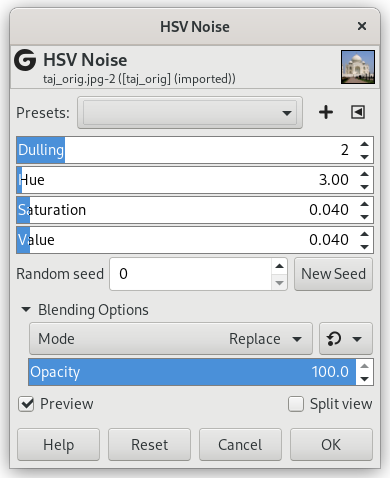Il filtro Rumore HSV crea rumore nel livello o nella selezione attivi usando il modello di colore Tinta, Saturazione, Valore (luminosità).
![[Nota]](images/note.png)
|
Nota |
|---|---|
|
If the image is in grayscale mode, this menu entry is disabled. |
- Preimpostazioni, «Tipo ingresso», Ritaglio, Opzioni di fusione, Anteprima, Fondi filtro, Dividi vista
-
![[Nota]](images/note.png)
Nota Queste opzioni sono descritte in Sezione 2, «Caratteristiche comuni».
- Monotonia
-
Questo cursore (1 - 8) controlla la quantità di colore del nuovo pixel che può essere applicata rispetto al colore esistente. Una monotonia bassa produrrà una variazione di tonalità significativa. Una monotonia elevata produrrà una variazione debole.
- Tonalità
-
Questo cursore modifica la tonalità dei pixel in modo casuale. Un valore più alto aumenterà la variazione media rispetto al colore originale del pixel.
- Saturazione
-
Questo cursore aumenta la saturazione dei pixel dispersi.
- Valore
-
Questo cursore aumenta la luminosità dei pixel dispersi.
- Seme casualità, Nuovo seme
-
Questa opzione controlla la casualità del filtro. La casella Seme casuale consente di inserire manualmente un seme per l'algoritmo di casualizzazione utilizzato. È anche possibile generare un seme casuale premendo il pulsante . Se si utilizza lo stesso seme casuale nella stessa situazione, il filtro produce esattamente gli stessi risultati. Un seme casuale diverso produce risultati diversi.






